In the eyes of a significant number of football game obsessives, the greatest names in the sport’s history have never appeared on the pages of a Panini album or cover of Four Four Two. Nor have they ever existed.
Yet to utter their names evokes nostalgia of a blissful, almost mythical era. Batustita and Ravoldi. Von Mistelroum and Roberto Larcos. Navdid and Naldorinho. These are the fictitious cult figures who helped turn Konami’s Pro Evolution Soccer series into one of the most revered football game franchises of all time.
It’s a phenomenon many devotees believe was born on the SNES, starting out as International Superstar Soccer. Yet while there’s a touch of romance to the tale, it isn't factually correct. PES was in fact born in the 1995 PS1 exclusive Goal Storm, developed at Konami's Tokyo studio. By contrast, International Superstar Soccer traces its ancestry to 1992’s Hyper Soccer on the NES, and was made some 300 miles west, in Osaka. Both series co-existed and remained distinct, other than Tokyo’s game eventually adopting the "ISS" acronym in its later years.
Although Goal Storm (known in Japan as World Soccer Winning Eleven) kick-started PES, when playing it today it's hard to find the series' DNA, other than in the theatrical commentary. It’s a frantic, end-to-end shot-fest that in no way hints at its future as a precise soccer sim. But much of this changed when a new director was sworn in to take command of the series. His name? Shingo "Seabass" Takatsuka.
Another Crab's Treasure Is A Soulslike 3D Platformer | GameSpot Review Stellar Blade Review Super Monkey Ball Banana Rumble - Official Multiplayer Features Trailer Nintendo 64 – April 2024 Game Updates – Nintendo Switch Online PUBG | Erangel Classic Returns Gori: Cuddly Carnage | Meow Launch Date Announcement Trailer Genshin Impact - "Arlecchino: Afterglow of Calamity" | Collected Miscellany Marvel Rivals - Official Loki Character Reveal Trailer | The King of Yggsgard Fortnite Festival - Official Billie Eilish Cinematic Season 3 Trailer Remnant 2 - The Forgotten Kingdom | DLC Launch Trailer Stellar Blade - Official "The Journey: Part 2" Behind The Scenes Trailer | PS5 Games Dead by Daylight | Tome 19: Splendor | Reveal Trailer
Please enter your date of birth to view this video
By clicking 'enter', you agree to GameSpot's
Terms of Use and Privacy Policy
"ISS Pro Evolution (1999) contained the immortal line, 'a great game, just a shame someone had to lose,' after a 1-1 draw."
With Takatsuka at the helm, Goal Storm became ISS Pro, and quickly became the sports game of choice for discerning fans with PlayStations. The best whack-a-goal efforts of the preceding decade (Sensible Soccer, FIFA, Actua Soccer, and International Superstar Soccer) all merited acclaim for their moreish action, yet none could truly claim to accurately simulate real football. Recreating the beautiful sport was ISS Pro’s objective from the outset, with a focus on build-up play and intelligent off-the-ball running, both of which would become series mainstays under Seabass’s tutelage.
(As an aside, there’s no great mystery behind the series chief’s unique nickname. “It’s just because he loves finishing seabass,” explains long-time colleague Akiyoshi Chosokabe, who joined Takatsuka’s team as a designer in the mid-‘90s.)
ISS Pro, and its three PS1 successors, showcase gameplay fundamentals that have survived to this day. The basic control scheme is near-identical, other than crosses assigned to R2 and one-twos activated with L2. Pacing is on just the right side of leisurely, allowing for patient approach play and intricate passing. And there are nine different in-match tactic tweaks available, such as Zone Press and Overlap. One idea that, sadly, had diminished over the years is player morale being represented by bouncing smiley faces on the line-ups screen. Who can forget the little grey guy’s told-off-toddler grimace?
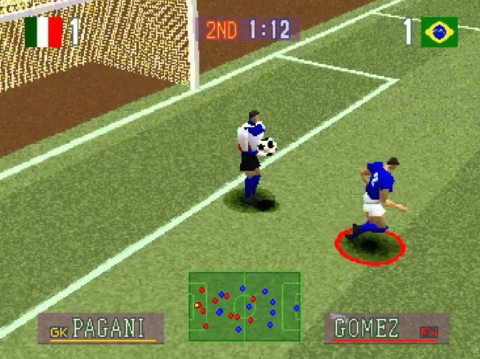
Off the pitch, things were considerably less polished during these formative years. To call the commentary from this era "laughable" is perhaps too diplomatic. From Martin Williams to Tony Gubba to Terry Butcher to Chris James, Konami experimented with different voices each year, all of which were mute-worthy. Analysis included half-hearted exclamations such as “that boy’s got a steel skull” and “oooh, whose ball will it be?”, while ISS Pro Evolution contained the immortal line, “a great game, just a shame someone had to lose,” after a 1-1 draw.
Thankfully, that third PS1 outing had something special up its sleeve to compensate: an innovative new mode called Master League. This was a sixteen-team division, in which you managed a side made up of fictional players, but could buy real ones with currency earned from victories. It made for rudimentary beginnings, but even then it was clear that this was the series’ future. (And without it, it’s questionable as to whether we’d now have FIFA Ultimate Team, loosely based upon the same model.)
As Master League was refined and improved over future iterations (more divisions, more teams, cup competitions, salaries, youth development) virtual managers discovered themselves overcome by a strange affliction: the inability to let go of the mediocre also-rans who initially populated their side. Few PES stalwarts can remember the real-life mid-tier footballers of that era, yet will cheerfully reel off the pretend achievements of the game's overachievers; Valery, Ximenes, Castello, Espinas. These monickers were sometimes altered between editions, yet always loosely the same players (forumites reacted angrily after the release of PES 2012, where most of these trusted favourites suddenly disappeared.)
"Master League had rudimentary beginnings at first, but even then it was clear that this was the series’ future."
“I wasn’t that much attached to Valery and Espinas,” reflects PES brand manager Andre Bronzoni, “but I could never replace Castolo [Castello’s later name] or Ximenes. They were always on my teams, and complement each other. Ximenes is faster and has a great pass; Castolo finishes very well and is a legend."
Bronzoni points to a relatively obscure ten-second YouTube video, stating "Castolo always helped my teams in many ways, he was the captain and number 10, scoring incredible goals like this one.”
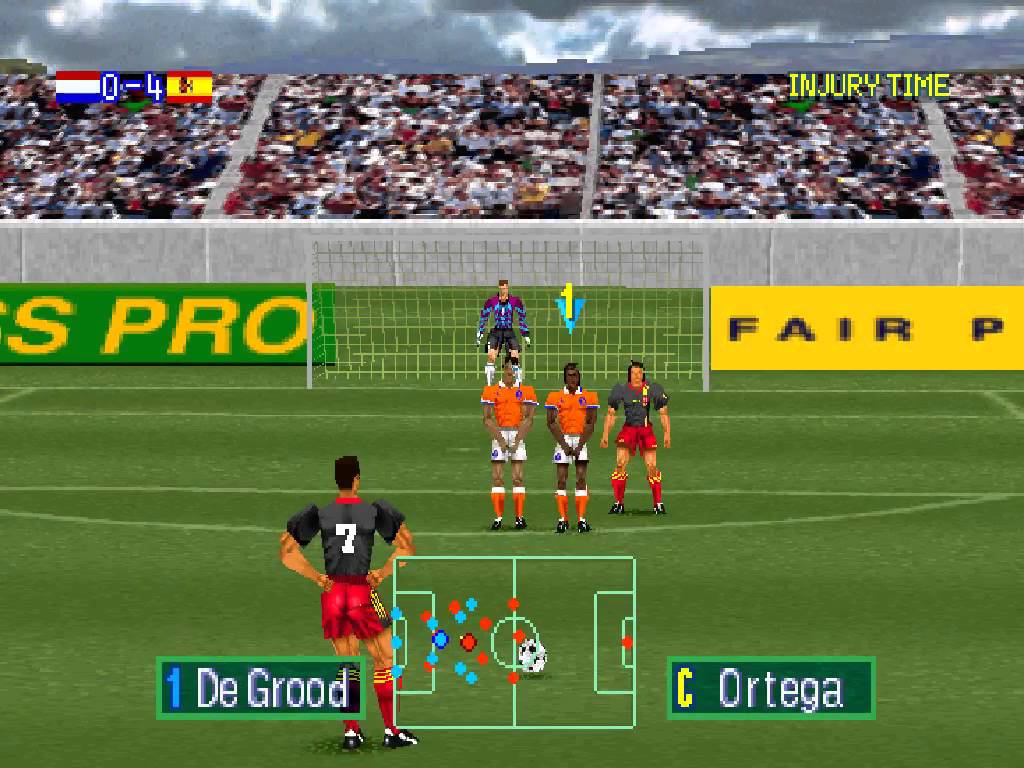
Peak Years
On 19 October 2002, a young Everton forward named Wayne Rooney became an instant icon by volleying a sumptuous winner against Arsenal. On its European release six days later, Pro Evolution Soccer 2 performed a similar, albeit metaphorical, trick. The series' enterprising-yet-flawed PS2 debut game, released a year earlier, had fans and critics alike opining that with a just few tweaks, this could be the outstanding sports game of the new millennium, and sure enough, Takatsuka’s team finally delivered the total football it had spent half a decade working towards.
The amendments between the two games seem minor now, but they were revelatory for the time. Individual players could control and turn in a single movement, and were given unique animations, such as David Beckham’s rugby-style run-up to free-kicks, or Robbie Keane’s somersaulting goal celebration. Both team-mate and opponent AI felt far more human, often making games against the computer as much fun as those versus actual friends. Even the commentary finally showed signs of maturation, with Peter Brackley and Trevor Brooking on mic duties. PES’s stature, like Rooney’s, had rocketed from promising to prime.
Annual releases from 2003 to 2006 told a similar story. PES 3 delivered deadly lofted through-balls and a Champions League equivalent for Master League (the WEFA Cup); PES 4 introduced player retirements and on-pitch referees; PES 5 improved opposition tactics and thunderous distance shooting; PES 6 added quick free kicks and additional physicality. While most changes were incremental, each new edition’s refinements immediately rendered the previous one redundant, so deft was Konami’s ability to stitch new elements into its complex tapestry.
“At first it was the lads playing it in hotel rooms, but it became a [squad-wide] competition."
Chelsea captain John Terry
Aiding the process was an unorthodox release schedule which saw Winning Eleven, the Japanese equivalent of PES, go on sale some months before the PAL version, and essentially act as a live testbed for the European edition, with feedback not just welcomed but encouraged.
“This is one of the most important things we have to do,” Takatsuka told Official PlayStation Magazine of this process in 2006. “We select the improvement comments of our fans and try to implement them in the game. We regard this as our top priority.”
Metacritic’s aggregate score rankings don’t stretch back to this era, but 9s and 10s abounded. It was generally agreed that football games had never had it so good, and the only thing preventing PES from eating into FIFA’s colossal sales figures were the licenses. Because Konami was unable to match EA’s spending on real teams and players, PES used predominantly fake names (with very obvious likenesses) to keep up with its rival. Hence the birth of unlikely legends such as Brontomerus-thighed Brazilian "Roberto Larcos."
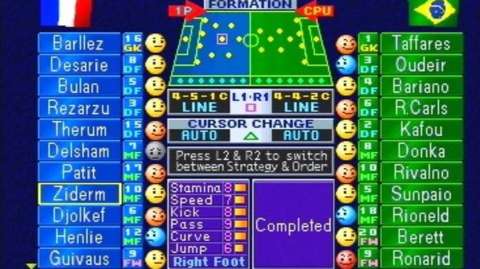
While the few remaining critics used this lack of licenses as an excuse to disparage Konami, many fans spanned it into a positive, and over the years found ways to make PES’s pretend players even more lifelike than FIFA’s official ones.
Datel’s X-Port, released in 2001, enabled the transfer of PS2 save data onto PC and back, in the process giving players the keys to edit content in their memory card files. Tech-minded devotees obliged. It became an annual tradition between PES 3 and 6 that some enterprising players would upload online various option files that contained correct team names, transfers and kit colours.
Perhaps not so coincidentally, Konami began to pack each annual release with comprehensive editing aids such as niche shirt designs, unconventional number fonts, and generic player faces ranging in handsomeness from "pretty" to "Peter Beardsley." As a result, those committed editors could keep the game authentic all year round. When Beckham suddenly switched hairstyles from peroxide streaks to cornrows, the same change could be made in PES 3. In FIFA 2003, by contrast, with appearances hard-coded and uneditable, fans were stuck with his old barnet.
Graham Day, community manager of pesfan.com (a fan site that launched in 2002, and whose success was intertwined with the proliferation of user-made option files) agrees that these licensing drawbacks only served to make the hardcore even more devoted.
“ISS and PES were founded on a simple mentality: playing great football. The game was always more important than the gloss,” says Day.
“I suppose the fact that we’d grown used to playing with teams like Bad Words United and Pizza Toppings on Sensible Soccer helped too. After a few years, it definitely started to add to PES’s charm. The fact that licences were regularly thrown around as one of the main arguments against it only helped to create a siege mentality. I remember feeling proud of choosing a game on its merits, not its financial muscle.”
It wasn’t just Day and his PESFan army. This golden era even saw Pro Evo love spill over from terraces to turf, with professional players coming out to declare their adulation. That mightn’t seem a big deal now with Premier Leaguers tweeting FIFA bantz on a daily basis, but in the 1990s it was unheard of--indeed, ex-Liverpool keeper David James was roundly mocked for admitting to playing games. By contrast, Chelsea skipper John Terry revealed in 2005 that late night PES 4 matches were a rite of passage for any prospect looking to break into the side.
“I got into it about five years ago,” Terry told Official PlayStation at the time, naming Glen Johnson and Joe Cole as the club’s best players. “At first it was the lads playing it in hotel rooms, but it became a [squad-wide] competition. Once you come into the first team you have to learn to play it.” The game had smashed down the barrier between the virtual and the real, and video games have been a huge, and very public, part of pro footballers’ downtime ever since.
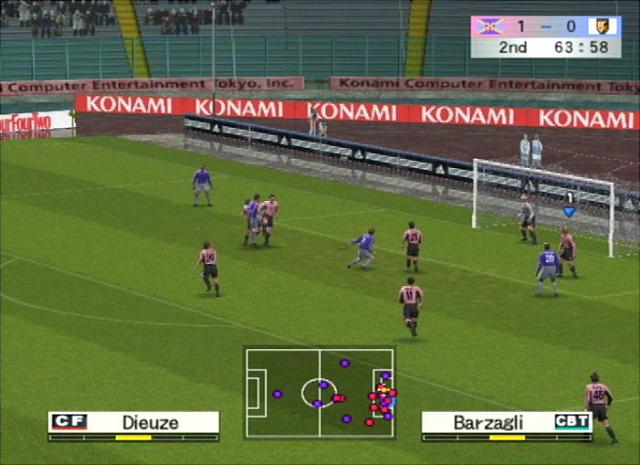
Sea Change
In the wake of PES 6’s release across two separate console generations (on PS2 and Xbox 360), Konami made a curious decision. There would be no PES 7: instead, each series would be named by year rather than version number. In theory the change was purely cosmetic, but looking back it also came to signify a downturn in fortunes which would take many years to overcome.
"I wouldn't say they are actively [copying us] right now. I'm saying they have a long history of copying PES to get to where they want to be.”
Ex-PES Team Leader Jon Murphy, on EA and FIFA, in 2012
Chief problem was the rethink not of nomenclature, but game engine: PES 2008’s debut on PS3 suffered countless troubles, among them constant stuttering and clunky reaction times. At a time when Call Of Duty was driving developers of all genres to focus online, 7th-generation PES encountered server woes and tales of players quitting without punishment. Customisation options were downgraded too, amid rumours that EA was looking at ways to protect its considerable investment in licences. Takatsuka went public to admit that this version was “so far from what we wanted”. Judged against its own high standards, PES was struggling.
As if that wasn’t enough of a sucker punch, Konami’s past glories indirectly catapulted FIFA to new heights. In August 2007, EA appointed former Championship Manager mastermind David Rutter to take its series forward on PS3 and Xbox 360. A sharp-minded Leicester City fanatic, Rutter spoke quite openly of his love for a certain rival product. ”I joined the company as a pretty ardent PES fan,” he told Eurogamer in 2009, “having spent many years looking at EA and the work they were doing and being somewhat dismissive of what was going on.”
FIFA was already on the up thanks to the sterling groundwork of a Scot named Gary Paterson, who was responsible for transformative innovations such as true ball physics and 360-degree running. Rutter, with Paterson at his side, continued along this path. The versions released from 2009 to 2011 saw it almost entirely ditch the marketing gimmicks of old, with an even heavier focus on sim-based gameplay, a change surely informed at least in part by the new overlord’s former love for Pro Evo.
There was not a single feature that you could pinpoint as being stolen, but late-2000s FIFA did indeed play uncannily like early-2000s PES, and previously partisan Konami disciples flocked to a series they’d spent years mocking. Within Konami, it was felt that EA’s footballing success had been achieved by slathering expensive gloss over its own adroitly constructed foundations.
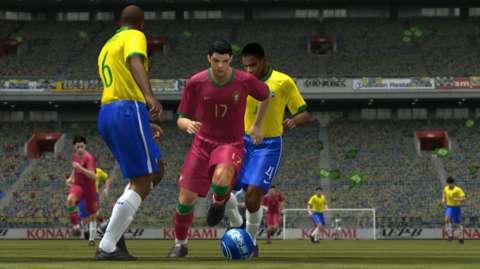
"I wouldn't say they are actively [copying us] right now. I'm saying they have a long history of copying PES to get to where they want to be,” PES team leader Jon Murphy told Eurogamer in 2012.
“People shouldn't forget that's how they got where they are. You can give them credit for it, and you can see [FIFA] as a totally valuable product in its own right that does have ideas we can all learn from, but we shouldn't forget that PES innovated all of this stuff and they did copy it.”
In the same interview, Murphy also explained the studio restructure, which surprisingly saw Takatsuka’s reign as series kingpin come to an end ahead of PES 2013. He said: “Seabass himself had got to a point where he was perhaps getting a bit frustrated as to how he would take the franchise on… His vision of football games hadn't developed as fast as the machines that could run football games. It gives us a chance to blood some new kids and force some new directions.”
Despite some nervous twitches from fans, the sea-change proved seismic. A back-to-basics attitude to gameplay, with more responsive controls and myriad possession options, saw lapsed fans return in droves--and an aggregate Metacritic score of 82, the series’ highest in six years. Hideo Kojima’s Fox Engine being utilised in Pro Evo for the first time a year later rubber-stamped its return to mid-2000s form.
Two years on, with the upcoming release of PES 2016, things have come full circle. The X-Port may be long defunct, but Pro Evo’s editing community remains as populous as it ever was. Despite FIFA’s sales advantage, it’s PES die-hards who defend "their" series most ardently, as old pub arguments over which is best now play out on an hourly basis via social media. Even the often incongruous commentary, these days supplied by Jon Champion and Jim Beglin, has come to be viewed as a charming strand of the series’ DNA.
The immediate future, then, looks secure. But what of the next 20 years? Without being able to give specifics, Bronzoni exudes confidence.
“There really is no limit to what the future holds for PES. We’ve picked up a lot of great momentum and our team has done an incredible job with elevating PES year over year. We’re broadening our horizons, listening to feedback and constantly pushing ourselves to make PES the best football experience. We’re very excited for what’s next."
"We have to prove [this resurgence] isn’t a fluke, and keep producing year on year. We can’t control licenses, but we can control quality.”
PES Product manager Adam Bhatti
Product manager Adam Bhatti elaborates: “We have a long-term plan, thanks to the Fox Engine. This is an engine that adapts year-on-year, and we’re still playing catch-up because it’s evolving while we’re working on it. So that secures our future. But one thing we can’t do these days is convince people using one or two games. We have to prove [this resurgence] isn’t a fluke, and keep producing year on year. We can’t control licenses, but we can control quality.”
PES 2016 arrives on 15 September, with glowing previews suggesting it’ll propel the series even closer to the dazzling triumphs of its heyday. This is a seasoned pro with a future as bright as its past, so long as Konami doesn’t embrace the Hollywood approach of resurrecting dusty IPs after a twenty-year hiatus. No one, ever, needs to see Goal Storm 2.

